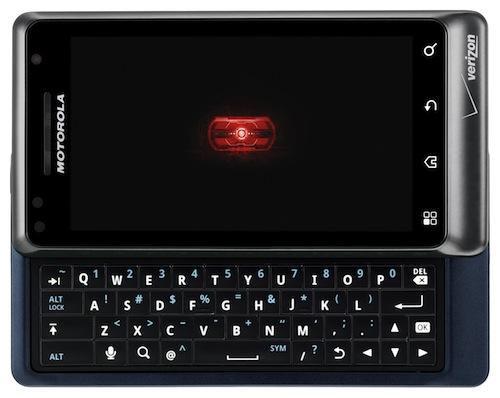
What's Good: 1 GHz processor, mobile hotspot capabilities, 8 GB of internal storage, and a much improved physical keyboard.
What's Bad: Battery life isn't great, and the signal strength indicator isn't very accurate.
The Verdict: The Motorola DROID 2 is the most well-rounded Android device on Verizon at the moment. Just be sure to carry a spare battery when you're traveling.
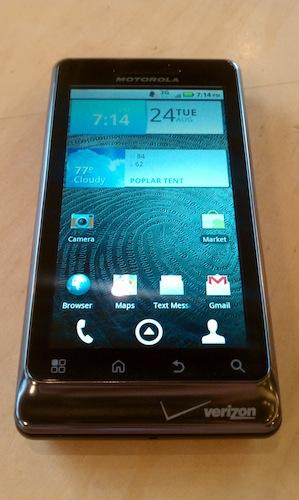
Announced in late 2009, the Motorola DROID was a game-changer. With a 600 MHz processor, Wi-Fi, and Android 2.0, the DROID was the high-end Android device to have at the time. Fast forward to the bottom half of 2010, and high-end Android devices have saturated the market. Save for the Samsung Epic 4G (which is slated for release on August 31st), the DROID 2 is the only high-end Android phone on a nationwide carrier that offers a physical QWERTY keyboard. With the option to choose between an on-screen or physical keyboard, the DROID 2 appeals to several demographics, and Verizon is well aware of it. Additionally, the DROID 2 offers a number of upgrades under the hood, including a faster processor, Android 2.2 out of the box, and a polished form factor. Are the changes enough to sway customers away from other options on the market?
The DROID 2 ships in a small box with the unit, battery, AC adapter module, USB cable, 8 GB microSD card (installed in the phone), and instruction manuals. Instead of the black and "brown sugar" color scheme, the device offers a blue and silver scheme. I liked the original color combination, but after working with the DROID 2, the blue and silver seems to fit better.

Minus the color change, the overall design is incredibly similar to the original DROID. The left side houses the microUSB charging port, while the volume rocker and camera shortcut button are on the right side. The power/lock button and 3.5mm headphone jack are on the top, and the 5-megapixel camera is on the back. Remove the battery door to find the microSD card slot. The DROID 2's hinge remains spring-free, and glides open with a firm click. Overall build quality is very good, with no creaks or wobbles to be found.
Coming in at 4.58 inches long by 2.38 inches wide by 0.54 inch thick, it's a bit larger than the original device. Under the hood, you get a 1 GHz TI OMAP processor, 8 GB of internal storage, mobile hotspot capabilities, and support for DLNA. The DROID 2 packs a 3.7-inch display in an 854 x 480 pixel layout, so the device is longer and narrower, making it easy to hold in the hand. At 5.96 ounces, it's heavier than some of the touchscreen-only devices, but still easy to throw in a pocket or bag.
The DROID 2 is the first device to offer Android 2.2 (Froyo) out of the box, but it's coupled with Motorola's Blur user interface. While the mere thought of Blur may conjure up images of the Backflip and Devour, it's the revised version like the one from the Motorola DROID X. In many cases, I prefer HTC's widgets over Motorola's, but am quite fond of their "Date & Time" and "Weather" options. More importantly, most of the Motorola widgets allow you to adjust their size. While one person may have a long and skinny weather widget, another person may opt for a short and fat version. While some will miss the vanilla Android experience that came with the original DROID, I'm pleased that Motorola added their Blur overlay to the DROID 2. As I've said before, I think the manufacturer-installed software overlays help bridge the gap between first-time smartphone users and seasoned veterans.
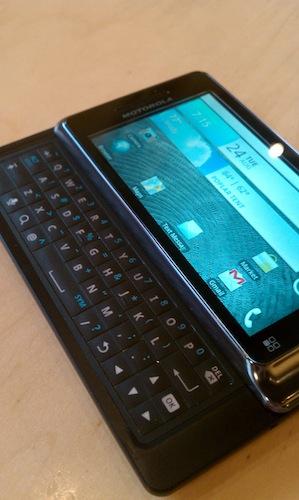
The on-screen keyboard offers narrow, tall keys. After working with the HTC EVO 4G and DROID X, both of which offer a 4.3-inch display, re-adjusting myself to typing on a smaller screen was challenging for the first few days. The DROID 2's physical keyboard is a huge improvement over the original device. The bulky D-pad is gone, replaced by arrow keys that are integrated into the keyboard itself. In addition to the keyboard being centered (making it much easier to type), the keys are raised, offering a nice level of tactile feedback. After a few minutes, I was typing with ease.
The 5.0-megapixel camera takes decent pictures, but it's no match to competitors like the iPhone 4, DROID Incredible, and DROID X. Editing options include eight scenes (auto, portrait, landscape, sport, night portrait, sunset, macro, and steady shot), eight effects (normal, black and white, negative, sepia, solarize, red tint, green tint, and blue tint), various resolutions, and more. The video camera quality is decent given the right amount of light, but seemed a bit grainy.

I tested the phone in the Charlotte metro area, and overall call quality was very good. The DROID 2's earpiece is incredibly bold and loud, and the dual-microphones seem to eliminate noise well. I visited a Verizon dead spot in Northeast Charlotte, and was able to make and receive calls, despite incredibly choppy call quality. Speakerphone worked well in the busy coffee shop that I frequent, and my callers were able to hear me over the grinders in the background. I paired two Bluetooth headsets to the device without any problems.
That said, after working with the DROID 2 for a few days, I have experienced the signal issues that are being discussed across the internet. Throughout the week, I watched as the bars of service fluctuated. Zero bars, one bar, four bars, back to zero. Back and forth between 3G and 1X. Though the indicator became much more consistent (and realistic) when I initiated a call or data session, it was frustrating to watch.
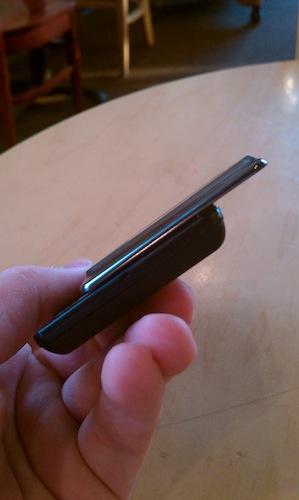
The DROID 2 offers a 1,390 mAh battery, so as you would expect, battery life isn't the greatest. For the first two days, I was unable to make it through the day due to heavy use like customization, Google Maps use, downloading of apps through the Android Market, calling, text messaging, e-mailing, and browsing the web. Once I got over the initial few days of customizing, I was able to make it through most of the evening before the device required a charge. Moderate users should be able to make it through a day without any issue. As is the case with any Android device, I would recommend a car charger and/or a backup battery.
The DROID 2 is a 3G device, sporting EVDO Rev. A connectivity. In speed tests, I received mixed results depending on my proximity to cell sites and network traffic. When I tested it in areas where signal strength was strong, I regularly hit download speeds of 2,000+ Kbps, and upload speeds of 900+ Kbps. In areas where signal strength was weak to moderate, I usually reached download speeds of 600-900 Kbps, and upload speeds of 400-600 Kbps. In casual web browsing, I found it to be reasonably fast, with few delays.
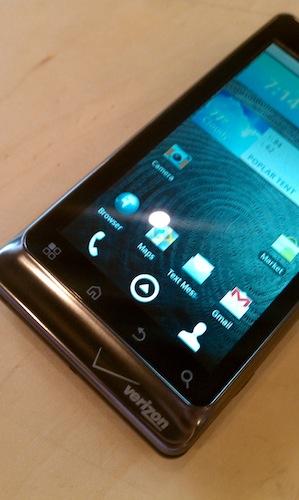
With Android 2.2 installed out of the box, the much-improved physical keyboard, and a 1 GHz processor, the DROID 2 is the most well-rounded Android device on Verizon. Theoretically, it appeals to the greatest number of people - the BlackBerry crowd (keyboard), Android die-hards (Froyo), people with small hands (3.7-inch display), and first-time smartphone buyers (MotoBlur). Like most Android devices, battery life isn't the greatest, and the constantly fluctuating signal strength indicator concerns me. The DROID 2 is in-stock with no delays (at the time of this writing) for $199.99 after mail-in rebate and two-year agreement, so those wanting the device can walk into a retail store and purchase immediately.